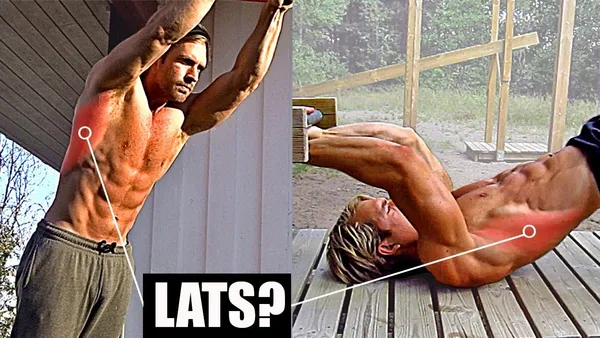Table of Contents
If you're looking to build a strong, defined back, lats calisthenics exercises are a great place to start. Calisthenics are bodyweight exercises that can be done anywhere, making them a convenient and effective way to get in shape. In this article, we'll discuss the best lats calisthenics exercises, and how to incorporate them into your workout routine. We'll also provide tips on how to progress your workouts and avoid injuries. Whether you're a beginner or an experienced athlete, there's something in this article for you. So if you're ready to get started, let's dive in!
The Ultimate Guide to Lats Calisthenics: Build a Wider, Stronger Back
I. Quick Takeaway
Exercise | Difficulty | Equipment |
|---|---|---|
Wide Pull-Ups | Intermediate | Pull-Up Bar |
Chin-Ups | Beginner | Pull-Up Bar |
Commando Pull-Ups | Advanced | Pull-Up Bar |
Negative Pull-Ups | Beginner | Pull-Up Bar |
Inverted Rows - Front and Back | Intermediate | Bar or Table |
Arch Pull-Ups | Advanced | Pull-Up Bar |
Australian Pull-Ups | Beginner | Branch or Bar |
Planche Leans | Advanced | None |
II. Calisthenics Equipment for Lats
Pull-Up Bars
Pull-up bars are the most essential piece of equipment for lat calisthenics. They can be used for a variety of exercises, including wide pull-ups, chin-ups, and commando pull-ups. Pull-up bars can be found in most gyms, or you can purchase one for home use.The Best Calisthenics Bars and Rings
Inverted Rows
Inverted rows are a great way to work your lats without using a pull-up bar. They can be performed using a bar or table. To perform an inverted row, simply grab the bar or table with your hands, and then lower your body until your chest is almost touching the bar or table. Then, pull yourself back up to the starting position.
Planche Leans
Planche leans are an advanced calisthenics exercise that can help you to develop incredible lat strength. To perform a planche lean, simply stand with your feet shoulder-width apart, and then lean forward until your body is parallel to the ground. Hold this position for as long as possible.
Exercise | Difficulty | Equipment |
|---|---|---|
Wide Pull-Ups | Intermediate | Pull-Up Bar |
Chin-Ups | Beginner | Pull-Up Bar |
Commando Pull-Ups | Advanced | Pull-Up Bar |
Negative Pull-Ups | Beginner | Pull-Up Bar |
Inverted Rows - Front and Back | Intermediate | Bar or Table |
Arch Pull-Ups | Advanced | Pull-Up Bar |
Australian Pull-Ups | Beginner | Branch or Bar |
Planche Leans | Advanced | None |
Calisthenics Equipment for Lats
III. Calisthenics Exercises for Lats
Beginner Exercises
Calisthenics exercises for lats can be a great way to build strength and muscle mass in your back. There are a variety of exercises that you can do, depending on your fitness level and goals. For beginners, some simple exercises to start with include:
- Chin-ups: Chin-ups are a great way to build strength in your lats and biceps. To do a chin-up, simply hang from a pull-up bar and lift yourself up until your chin is over the bar. Lower yourself back down to the starting position and repeat. For kipping chin-ups, you can generate momentum to help you get over the bar.
- Negative pull-ups: Negative pull-ups are a good way to build strength in your lats if you are not strong enough to do a full pull-up. To do a negative pull-up, simply jump up to the top of a pull-up bar and slowly lower yourself back down to the starting position. Negative training is when you only do the eccentric phase of a movement. You can use this technique to make many different calisthenics exercises harder.
- Australian Pull-Ups: Australian pull-ups are a great way to work your lats if you do not have access to a pull-up bar. To do an Australian pull-up, find a low branch or bar and place your hands on it so that your palms are facing you. Step back so that your body is at a 45-degree angle to the ground and pull yourself up until your chest touches the bar.
Intermediate Exercises
Once you have mastered the beginner exercises, you can start to progress to more challenging ones. Some intermediate exercises to try include:
- Wide pull-ups: Wide pull-ups are a variation of the regular pull-up that targets your lats more than your biceps. To do a wide pull-up, simply grip the pull-up bar with your hands wider than shoulder-width apart and pull yourself up until your chin is over the bar.How to do a muscle up?
- Commando pull-ups: Commando pull-ups are a more advanced variation of the pull-up that requires you to use a close grip and pull yourself up until your chest touches the bar. To do a commando pull-up, simply grip the pull-up bar with your hands shoulder-width apart and pull yourself up until your chest touches the bar.
- Inverted rows: Inverted rows are a great way to work your lats and biceps if you do not have access to a pull-up bar. To do an inverted row, simply find a bar or table that is about waist-height and place your hands on it so that your palms are facing you. Step back so that your body is at a 45-degree angle to the ground and pull yourself up until your chest touches the bar.
Advanced Exercises
If you are looking for a challenge, there are a number of advanced calisthenics exercises that you can try. Some advanced exercises to try include:
- Arch pull-ups: Arch pull-ups are a variation of the regular pull-up that is more difficult because it requires you to arch your back. To do an arch pull-up, simply hang from a pull-up bar and lift yourself up until your chest is over the bar. As you pull yourself up, arch your back so that your body forms an upside-down U-shape. Lower yourself back down to the starting position and repeat.
- Planche leans: Planche leans are a challenging exercise that requires you to hold your body in a straight line from your shoulders to your feet. To do a planche lean, simply stand with your feet shoulder-width apart and lean forward until your body is at a 45-degree angle to the ground. Hold this position for as long as you can and then return to the starting position. Repeatedly doing this motion develops core, shoulder, lower back, lats and tricep strength at the same time.
No matter what your fitness level, there are a variety of calisthenics exercises that you can do to work your lats. By incorporating these exercises into your routine, you can build strength and muscle mass in your back.
Exercise | Difficulty | Equipment |
|---|---|---|
Wide Pull-Ups | Intermediate | Pull-Up Bar |
Chin-Ups | Beginner | Pull-Up Bar |
Commando Pull-Ups | Advanced | Pull-Up Bar |
Negative Pull-Ups | Beginner | Pull-Up Bar |
Inverted Rows - Front and Back | Intermediate | Bar or Table |
Arch Pull-Ups | Advanced | Pull-Up Bar |
Australian Pull-Ups | Beginner | Branch or Bar |
Planche Leans | Advanced | None |
Calisthenics is a great way to get in shape and build strength. If you are looking for a challenging and rewarding workout, give calisthenics a try. You may be surprised at how quickly you see results.
Related Posts:
- The Best Calisthenics Exercises and Variations
- How to Build Muscle and Strength with Calisthenics
- Calisthenics: The Ultimate Guide
Calisthenics Exercises for Lats
IV. Creating a Calisthenics Training Plan for Lats
Frequency and Volume
The frequency and volume of your lats calisthenics training will depend on your fitness level and goals. If you are a beginner, start with 2-3 workouts per week, focusing on compound exercises that work multiple muscle groups. As you progress, you can increase the frequency and volume of your workouts to 4-5 times per week, and incorporate more isolation exercises to target your lats specifically.
Here is a sample calisthenics training plan for lats:
Day | Exercises | Sets | Reps |
|---|---|---|---|
Monday | Wide Pull-Ups | 3 | 8-12 |
Chin-Ups | 3 | 10-15 | |
Inverted Rows | 3 | 12-15 | |
Tuesday | Rest | ||
Wednesday | Commando Pull-Ups | 3 | 6-10 |
Negative Pull-Ups | 3 | 8-12 | |
Arch Pull-Ups | 3 | 10-15 | |
Thursday | Rest | ||
Friday | Australian Pull-Ups | 3 | 12-15 |
Planche Leans | 3 | Hold for 30 seconds | |
Rest | |||
Saturday | Rest | ||
Sunday | Rest |
You can adjust this plan to fit your own needs and goals. For example, if you are a beginner, you may want to start with fewer sets and reps, and gradually increase the intensity of your workouts over time. If you are more advanced, you may want to add more weight or resistance to your exercises.
No matter what your fitness level, it is important to listen to your body and rest when you need to. Overtraining can lead to injuries, so it is important to progress gradually and avoid pushing yourself too hard.
Related post: How to Design Your Own Calisthenics Routine and Program
Progression
As you progress in your lats calisthenics training, you will need to challenge yourself in order to continue to see results. There are a few different ways to progress your training:
- Increase the weight or resistance
- Increase the number of sets and reps
- Decrease the rest time between sets
- Add more advanced exercises
Which method you choose will depend on your individual needs and goals. If you are unsure how to progress your training, it is always a good idea to consult with a qualified personal trainer.
Related post: How to Progress Your Calisthenics Training
Creating a Calisthenics Training Plan for Lats
V. How to Progress your Lats Calisthenics Training
Increase the Difficulty of Your Exercises
As you get stronger, you'll need to challenge your muscles more to continue seeing progress. There are a few ways to do this:
- Increase the number of repetitions you do in each set.
- Increase the number of sets you do in each workout.
- Increase the weight you're using (if you're using weights).
- Decrease the amount of rest you take between sets.
- Try more advanced variations of exercises.
For example, if you're currently doing 3 sets of 10 reps of pull-ups, you could try doing 4 sets of 12 reps, or 3 sets of 12 reps with a weight vest.
Change the Tempo of Your Exercises
The tempo of an exercise is the speed at which you perform it. By changing the tempo, you can make an exercise more or less challenging.For example, if you're currently doing pull-ups at a moderate tempo, you could try doing them at a slower tempo, or a faster tempo.
Incorporate Supersets and Drop Sets
Supersets and drop sets are two advanced training techniques that can help you to progress your lats calisthenics training.Supersets involve doing two exercises back-to-back with no rest in between. This can help to increase the intensity of your workout and to save time.Drop sets involve doing a set of an exercise to failure, and then immediately dropping the weight and doing another set to failure. This can help to increase the volume of your workout and to challenge your muscles in a new way.
Related Posts:
- How to Do a Muscle Up
- The Best Calisthenics Gifts and Accessories
- The Best Calisthenics Quotes and Motivation
Use a Training Log
A training log is a great way to track your progress and to identify areas where you need to improve. In your training log, you should record the following information:
- The date of your workout.
- The exercises you did.
- The number of sets and reps you did of each exercise.
- The weight you used (if you're using weights).
- The tempo of your exercises.
- How you felt during your workout.
By reviewing your training log, you can see what's working and what's not, and you can make adjustments to your training program accordingly.
Related Posts:
- How to Get Started with Calisthenics as a Beginner
- The Best Calisthenics Supplements and Nutrition
- How to Do a Squat
Be Patient and Consistent
Progressing your lats calisthenics training takes time and consistency. Don't get discouraged if you don't see results immediately. Just keep at it and you will eventually reach your goals.Here are some additional tips for progressing your lats calisthenics training:
- Make sure you're eating a healthy diet that supports your training.
- Get enough sleep.
- Listen to your body and take rest days when you need them.
- Find a training partner or group to help you stay motivated.
- Have fun!
Exercise | Difficulty | Equipment |
|---|---|---|
Wide Pull-Ups | Intermediate | Pull-Up Bar |
Chin-Ups | Beginner | Pull-Up Bar |
Commando Pull-Ups | Advanced | Pull-Up Bar |
VI. Conclusion
Calisthenics is a great way to improve your overall fitness. It's a versatile form of exercise that can be done anywhere, and it's relatively inexpensive to get started. If you're looking to add some variety to your workouts or you're just getting started with calisthenics, there are plenty of resources available to help you get started. You can find instructional videos and articles online, or you can join a local calisthenics group. With a little effort and dedication, you can achieve your fitness goals with calisthenics.